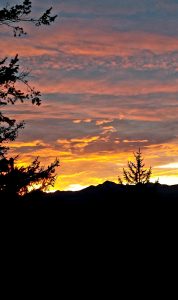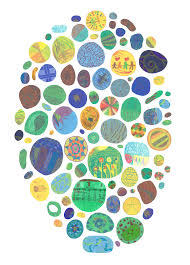By Kay Stoltz
You’re invited! Out of the blue an invitation arrives to celebrate a birthday of someone I hadn’t seen in months. I’ve been thinking of her in connection with some research I started a few months ago. Although we had just met, she gave me an intro I needed to get involved in the Library. Then we lost touch, as we move in different circles. That intrigued me, moving in different circles. How does it happen in a small town?
Circles are defined as groups of people of like interests, causes or lifestyle who gather together. What are the circles here? Do they evolve into friendships? There are few “after event events” happening from what I’ve observed. And meaningful relationships coming from circles are rare.
The day of the party, bright and sunshiny, is mirrored in the happy sounds coming from the party. And there’s the birthday girl, just inside, holding court. She welcomes me with the usual coastal hug; a sideways, one-armed approach given as casually as a handshake. No matter if you’ve lived here ten years or ten minutes, the greeting is universal, and doesn’t rely on outward appearances, connections or any other marker. The acceptance of newcomers is complete and non-judging.
The crush of new arrivals doesn’t allow more than a few words with the honoree. I move to a spot where I have a good view of the crowd and review what I have learned. I assigned “Lifestyle Groups” by asking how long people have lived here, where they came from, and why they picked this town. “Circles” are the social, educational, or political interest organizations that people join.
The first lifestyle group is pretty easy since most of us fall into it: Retirees. They move in with few or no ties in place, and time on their hands. The circles of volunteer groups quickly recruit them. They join those which fit their interests: go to meetings, fill their time with good works.
Socials believe retirement means exploring their artistic side. A small social circle is all they need, one or two couples. These people are glad for the anonymity they have here.

Some citizens, Old-timers, remember days of simplicity. They came thirty-forty years ago to a sleepy town off the highway with a great beach. Their laid-back, casual mode of living is still strong. Every improvement/change means more expense, and a threat to their lifestyle.

The Newbies love beach living, but want the conveniences they enjoyed in the City: paved streets and sidewalks, technology, and the square feet of living space. They are civic-minded, quickly join and become leaders in influential circles. They make “improvements”, expenses go up, rules change.
Friction develops as these Lifestyle Groups have different agendas. Shouldn’t circles bind people together as friendships are formed and compromises happen? From my vantage point at the party, I see best friends (or let’s be best friends) greeting each other. I don’t hear plans for a meet-ups. The statements: “I’ll call you.” or “Call me when you get a minute” are vague and may or may not happen.
Usually, the contacts made at meetings, events, etc. lead to the next step: follow-up coffee/drink dates where deeper connections are made. I don’t see that happening.
From Old-Timers: “What happened to the spur-of-the-moment, ‘let’s get together’ telephone call?” a man wonders.
“Everything is formal. It has to be perfect, so nobody does it.” his wife answered.
From Retirees, only half kidding: “Who’ll do the dishes?”
We don’t want the stress, or to take the time to host a dinner party?
Another from Retirees mused, “Let’s say there are 600 people here, and you know 300 and I know 300. You realize they are, for the most part, completely separate groups of people? How does that happen?”
I don’t know. And given that most Circles don’t mix, how did she and I get to be good friends?
How does one break into a community? What’s a good friend? Someone one could call at three AM in an emergency? Who is that person? I asked that question of a group of writers. One said, “My neighbor. She’s full time like I am, so she checks my potted plants when I’m gone and I feed her dog when she’s gone.”
There are neighborhoods where full time owners are few or non-existent. It’s harder to make connections. Where are circles for them?
Rainy Day Village, a new group, is forming in answer to the needs of our community: an aging population and lack of resources. Briefly, it is an organized help system. One joins, pays a fee, and things one can’t do can be possible from a pool of volunteers. The leaders are setting up informal “meet and greets” to explain the Villages concept and develop closer ties in our community.
And then, we have “THE EVENT”. Mother Nature shows who’s in charge. The tornado of recent years revealed the basic character of this town: neighbor helping neighbor, chainsaws reclaiming streets and yards, quiet assistance to businesses existing on tight budgets. The threat of Tsunami and earthquake have mobilized groups to form Neighborhood Preparedness Groups. Another circle?
People respond to emergencies, not daily life and mundane items like maintenance and repairs. However, even quaint, charming villages need updating of their public buildings.
Old-Timers ask: How much will it cost?
Newbies answer: let’s not figure that. Let’s build something for the FUTURE!
“Not so fast. Another $200 tax per thousand of appraised value? My expert says the less expensive plan will work.”
Newbies love the new design of City hall with its soaring roofline, latest building materials, pristine modern look.
Socials say, “Sleek and modern, yes; it looks like it will take flight. It doesn’t fit our cedar shake village.”
“This is what we need: new ideas, new technology.” is the rebuttal.
We share a love of art, the environment, and the unrivaled setting.

The next step is respectfully using this common creativity and passion for inclusiveness.


